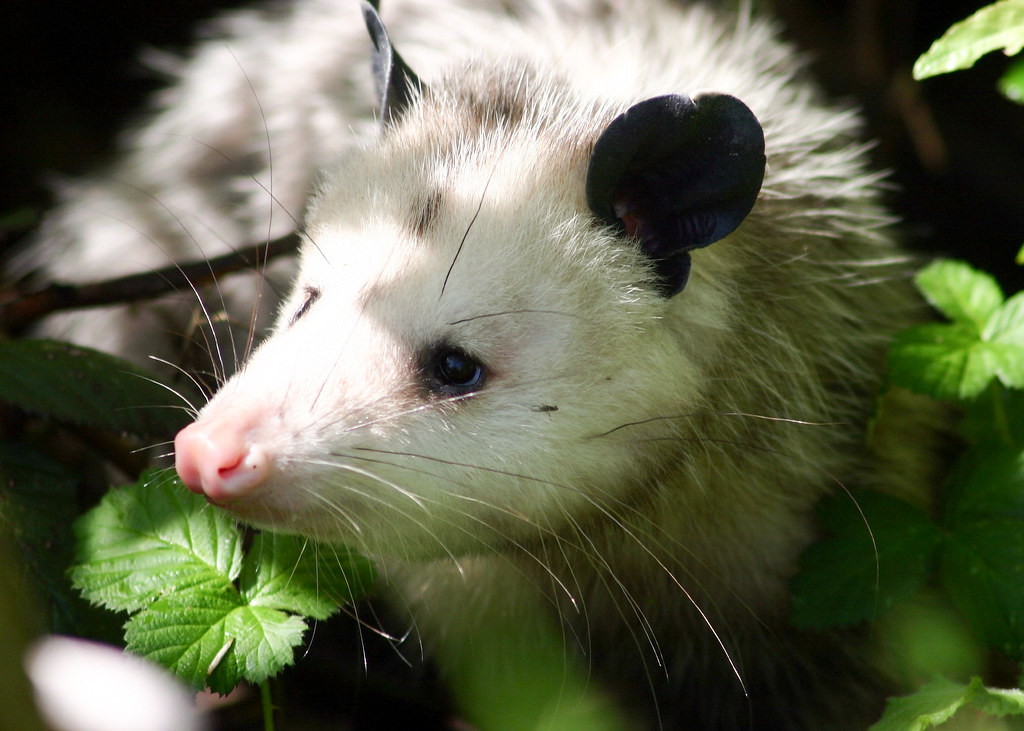Virginia Opossum
Didelphis virginiana
The Virginia opossum is a gray, heavyset mammal found throughout the Chesapeake Bay watershed.
This section shows one large critter image at a time. Use the thumbnails that follow to select a specific image to display here.

This gallery contains a grid of small thumbnails. Selecting a thumbnail will change the main image in the preceding section.
Appearance
The opossum has a heavyset body covered with grayish fur. It has a white face and thin, black ears. Its long head has a pointed snout, long whiskers and 50 sharp teeth. It has a long, tapered, scaly tail. Each foot has five toes; one toe is opposable. Opossums grow to about 25 to 40 inches in length and weigh four to 14 pounds. Males are usually larger than females.
Feeding
Opossums consume a wide variety of plants and animals. They eat mostly insects and dead animals, but will also eat just about anything else, including fruits, seeds, snakes, mice, frogs and garbage.
Predators
Predators include owls, hawks, red foxes, cats, dogs and humans. Opossums protect themselves from predators by “playing dead,” since most predators will not eat an animal that is already dead. This is actually an involuntary reaction due to shock: the opossum falls onto the ground and lies motionless on its side with its eyes and mouth open, and it awakens when the danger passes.
Opossums may also try to bluff predators into thinking they are aggressive by hissing and baring their teeth when feeling threatened. Most opossums are killed by cars because they have poor hearing and eyesight.
Voice
Virginia opossums produce clicking noises when they are trying to attract mates and hiss or growl when they feel threated. Baby opossums make noises that sound like sneezing when trying to get their parents' attention.
Reproduction and life cycle
Mating occurs between January and July. After 12 to 13 days, the female gives birth to a litter of seven to nine young that are about the size of a dime. The tiny young crawl into their mother’s belly pouch and attach to a nipple. They remain in the pouch for about two months to develop. After they leave her pouch, the female carries her young on her back when she travels. Young remain with the female until they are about four months old, reaching sexual maturity at six to 12 months old. Opossums rarely live longer than 18 months.
Did you know?
- Opossums are nocturnal.
- An opposum spends much of its time in trees and will live in dens in hollow logs, tree cavities, rock piles, old nests and burrows, and under decks and buildings.
- They are the only marsupial native to North America
- Name comes from the Algonquian word apassum, meaning “white beast.”
- Opposums do not hibernate in winter. Females may live in groups but males are solitary.
- The oldest opossum ever collected in the wild was three years old.
- Opossums are excellent climbers that use their toes and tails to grasp branches.
- They are very susceptible to frostbite: it is not unusual to see an opossum that is missing an ear, toes or the tip of its tail.
Sources and additional information
- Chesapeake Bay: Nature of the Estuary, A Field Guide by Christopher P. White
- Animal Diversity Web: Didelphis virginiana – University of Michigan Museum of Zoology
- NatureWorks: Virginia Opossum – New Hampshire Public Television
